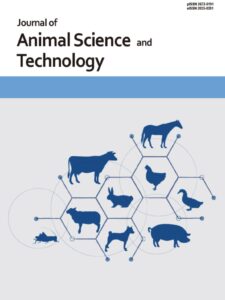Publications

Applicability of non-invasive, digital palpation device to detection of woody breast conditions in chicken breast muscle
Authors: Sang-Hyon Oh 1, Euyeon Noh 2, Byungrok Min 2
Affiliations:
- Division of Animal Science, Gyeongsang National University, Jinju 52725, Korea
- Department of Agriculture, Food, and Resource Sciences, University of Maryland Eastern Shore, Princess Ann 21853, United States
Journal: Journal of Animal Science and Technology - February 2024, Volume 66, Issue 5, Pages 1069-1078 (DOI: 10.5187/jast.2024.e14)
-
Field & Applications:
- Animal studies
- Musculoskeletal disorder
Woody Breast (WB) is one of muscle myopathy found in chicken breast, characterized with enlarged size and extremely stiff texture. The WB condition is one of the most prevalent quality issues in the modern poultry industry. WB has been shown to be heritable, but no effective detection method of WB severity in live birds exists for the selection purpose.
The objective of this study was to determine potential of a non-invasive, portable digital palpation device as WB detection method that can be used for the selection to estimate the heritability of WB. The physical and functional properties of WB was also investigated in comparison with normal breast (NB).
Two hundred ten breast muscles were obtained from a local processing plant one day after harvest and sorted based on WB scoring (1 for NB and 2 and 3 for WB). The samples were subjected to physical and physicochemical analyses, determining biomechanical properties (muscle tone, stiffness, elasticity, relaxation, and creep), pH, color, cooking yield, and texture (firmness and compression energy were used for raw meat and shear force and energy for cooked meat).
The least squares means of the following variables were significantly different between WB and NB (p<0.01): stiffness (603.4 vs 565.8; N/m), and elasticity (1.40 vs 1.55). However, relaxation and creep were not significantly different (p>0.05). These results collectively showed that biomechanical properties of WB differ from NB. The degree of muscle stiffness in WB can be considered as a trait to be selected. The WB score showed strong negative correlations with cooking yield (-0.77) and cooked L*(-0.74), which means that as the breast becomes harder, the cooking yield decreases, and the color becomes darker after cooking.
The WB score showed high correlations with physical and functional characteristics and exhibited strong correlations with the biomechanical properties measured by the device. Therefore, the results indicated that the digital palpation device has potential to detect the WB severity (degree of stiffness) of breast muscle.
Keywords: woody breast, MyotonPRO, characteristics, broiler, breast meat
In this study, WB was found to be measurable with a device and it has a variation, which means that chickens would be selected based on the severity of WB. We knew that the severity in the symptom of WB (meat) could be scored (quantified) as a phenotype. The next stage of the study will score the parameters of breast muscle during the growth of broilers (live birds) to assess the exact time or time interval of when WB can be detected and indexed to pinpoint the onset of WB in growing broilers. Each individual can be scored based on its severity, and the scores will be used to select the chickens to be mated. In sum, a selection study will bepossible with this proposed study to establish a genetic line to minimize the severity of WB while maximizing the growth rate and all other economically important traits using genetic (pedigree) information and quantitative genetics (statistical animal breeding).


